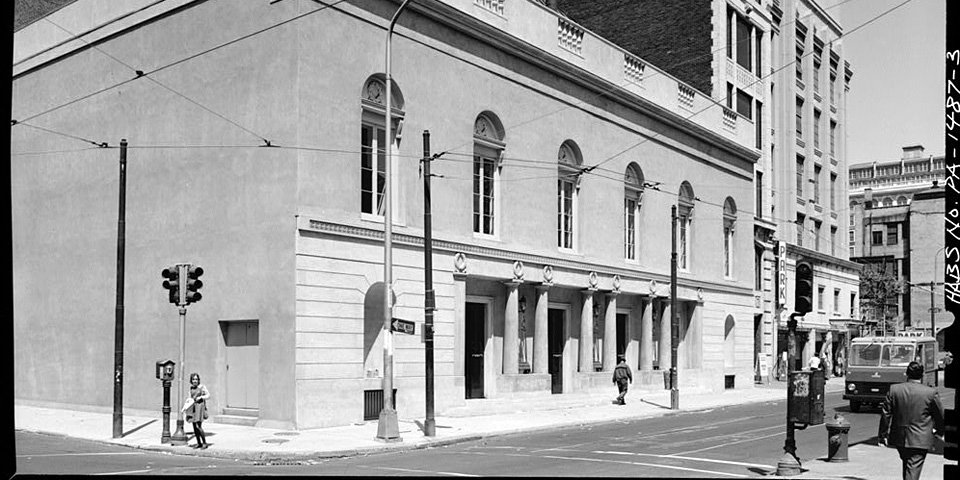 Etching, 1831, Courtesy of the Pennsylvania State Archives
Etching, 1831, Courtesy of the Pennsylvania State ArchivesStanding at the corner of Ninth and Walnut Streets in Philadelphia for two hundred years, Walnut Street Theatre's National Historic Landmark structure has housed two centuries' worth of American popular entertainment. Most noteworthy American actors of the 19th century and many from the 20th century have appeared on stage at the Walnut. Some of the Walnut's shining stars include: Edwin Forrest, Edwin Booth, Edmund Kean, the Drews, the Barrymores, George M. Cohan, Will Rogers, The Marx Brothers, Helen Hayes, Henry Fonda, Katharine Hepburn, Marlon Brando, Jessica Tandy, Ethel Waters, Audrey Hepburn, Sidney Poitier, Lauren Bacall, George C. Scott, Jane Fonda, Robert Redford, Julie Harris, Jack Lemon, and William Shatner. Over the years audiences have clapped and cheered for circus, opera, vaudeville, lectures, music, dance, motion pictures, and of course, the live theatre productions for which it is best known today.
When the theatre opened its doors on February 2, 1809, the pounding of hooves mingled with the shrieks of delight from the crowd as teams of horses circled a dirt riding ring. A few years later, an 80-foot dome was added to the theatre, making it the tallest structure in Philadelphia at that time. The theatre's career as an equestrian circus did not last long, however, and by 1812 the building had been converted to a legitimate theatre, featuring a real stage where the ring had stood. The Walnut's first theatrical production, The Rivals, had President Thomas Jefferson and the Marquis de Lafayette in attendance on opening night.
In 1820, Edwin Forrest, a young Philadelphian who would have a profound impact on American drama, made his professional debut on the Walnut stage at age 14. In 1828 John Haviland, the most prominent architect of his day, designed major renovations to the interior and exterior of the building. The present façade is based on his original design.
 Exterior, 1900
Exterior, 1900Walnut Street Theatre is home to many firsts in the American theater scene. In 1837, the Walnut was the first theatre to install gas footlights, and in 1855, the Walnut became the first theatre to install air conditioning. The first copyright law protecting American plays had its roots at the Walnut. The curtain call, now a tradition in every theatre, started at the Walnut with the post-play appearance of noted 19th Century actor Edmund Kean.
In 1863, the theatre was purchased by Edwin Booth, a son of one of the most famous theatrical families of the day. Unfortunately, fame would soon turn to notoriety for Booth when his brother John Wilkes Booth assassinated the President at Ford's Theatre in Washington, DC. Edwin Booth, with his business partner and brother-in-law, John Sleeper Clark, managed to hold on to the Walnut in those dark days and go on to guide it for many years.
During the 1880s, the Walnut experienced many renovations, including a new stage for more elaborate musical comedies. In 1920, the interior was again rebuilt within the old exterior using structural steel in a design by William H. Lee.
The Walnut remained a significant player on the American theatre scene throughout the twentieth century. Purchased by the Shubert Organization in the 1940s, the theatre was home to many pre-Broadway try-outs of plays that would go on to become American classics, such as A Streetcar Named Desire starring Marlon Brando, A Raisin in the Sun featuring Sydney Poitier, and The Diary of Anne Frank featuring Susan Strasberg. Mister Roberts, starring Henry Fonda, opened at the Walnut in 1948. Fonda, recently discharged from the Navy, used his own uniform in the play. His daughter, Jane Fonda appeared in There Was a Little Girl in 1960. In 1961, Neil Simon's first Broadway play, Come Blow Your Horn debuted.
 Courtesy of the Library of Congress, Prints & Photographs Division
Courtesy of the Library of Congress, Prints & Photographs DivisionThe Walnut's rich history is evident backstage as well, as it is one of only a few remaining "hemp houses" in the country. To this day it continues to operate the original grid, rope, pulley, and sandbag system that was in use nearly two centuries ago. The theatre's hand-painted fire curtain, which still hangs above the stage, displays a reproduction of the The Liberty Bell's First Note, 1753, originally painted by Jean Leon Gerome Ferris.
In 1964, Walnut Street Theatre was designated a National Historic Landmark. Then in 1969 the theatre was renovated again to become a Performing Arts Center. During this period a variety of live entertainments were represented at the Walnut including dance, music, and theatre. In 1976 the Walnut hosted the first televised Carter-Ford presidential debate.
The Walnut began its most recent incarnation as a self-producing, non-profit regional theatre when Bernard Havard took the helm in 1982, founding the Walnut Street Theatre Company with a vision of once again creating theatre in a space that is so steeped in the American theatre's traditions and history. Today, you can experience the realization of that dream when you attend a live performance. With nearly 50,000 subscribers annually, the Walnut Street Theatre is the most subscribed theatre company in the world.